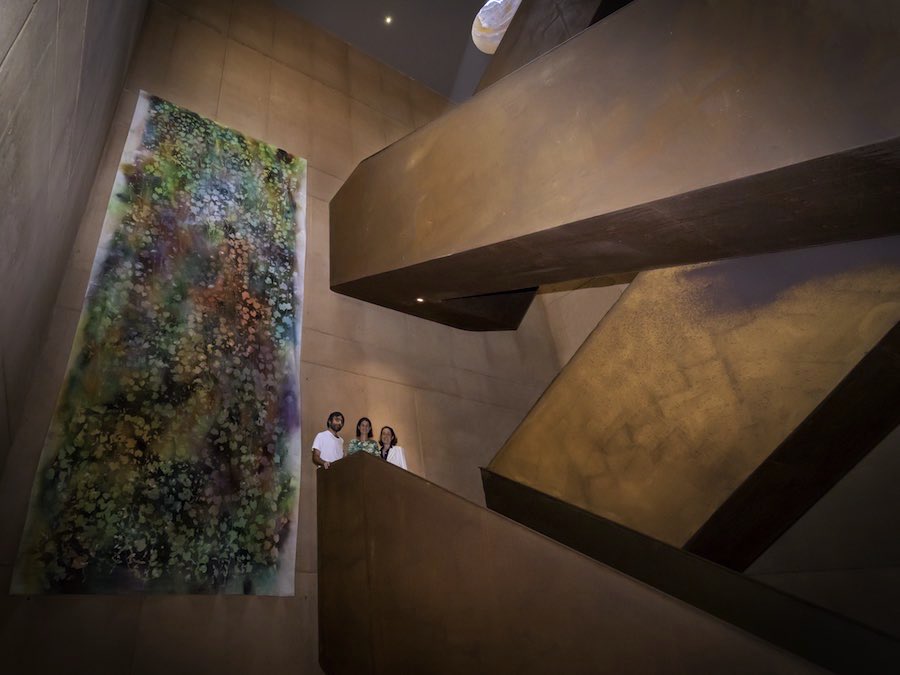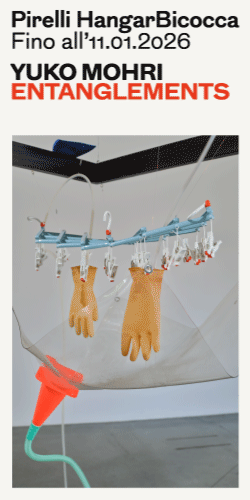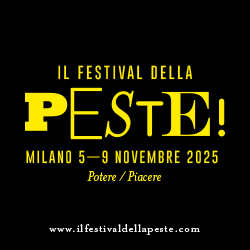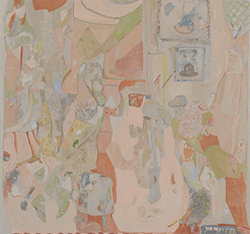
English text below
La fascinazione subita dall’artista californiano Sam Falls – nato a San Diego nel 1983 e di stanza a Los Angeles – nei confronti del paesaggio di cantine Antinori nel Chianti Classico, non pare scaturita, come si potrebbe pensare, dalla decisività dell’elemento solare.
Anzi, come ci racconta Ilaria Bonacossa, curatrice del progetto site-specif “Untitled (Antinori)” realizzato dall’artista per Antinori Art Project, è la “tenerezza del notturno” a generare i suoi monumentali frottage vegetali.
“Sam Falls – ci racconta Bonaccosa – stende durante la notte delle tele tra le vigne cercando di cogliere la traccia delle foglie, degli animali e dei pigmenti stesi in maniera apparentemente randomica”.
Sorta di photogenic drawing impresso di mille colori, entità prossima all’ombra, alla traccia o all’impronta, l’opera di Falls restituisce nella delicatezza del pigmento il segno visibile di un passaggio al limite dell’impercettibile.
Distante dall’energia virile in qualche modo intrinseca alla Land Art americana – orientamento che l’artista ci descrive, sorridendo, come “macho” – Falls dimostra una discrezione nell’addentrarsi tra le vigne e nella bruma femminile, ludica, ambigua e trasparente. La tela raccoglie su di sé presenze minime e tiene memoria della loro essenza così che, nelle parole della curatrice, “ I fiori e le foglie di vite, esposti per cinque notti e durante un temporale, proteggono la tela dal pigmento, divenendo delle sorti di sindoni della natura”.
ATPdiary ha fatto alcune domande all’artista.
ATP: Il lavoro che proponi per Antinori Art Project, “Untitled (Antinori)”, è fortemente legato al luogo, la cantina a Bargino. Mi racconti come è nato e quali aspetti hai considerato per la sua ideazione?
Sam Falls: Credo che Alessia Antinori abbia visto il mio lavoro per la prima volta all’Hammer Museum, mentre Ilaria Bonacossa alla Galleria Franco Noero, quindi ci siamo incontrati a Torino e sono stato invitato a immaginare un progetto. Sono stato quindi in Toscana e ho visitato la cantina per un sopralluogo e mi ha attratto particolarmente per via dell’attenzione alla natura, soprattutto sapendo che si sarebbe trattato di un progetto all’aperto, in cui poter lavorare completamente immerso nelle vigne e nelle piante che mi circondano. In seguito alla visita ho deciso che avrebbe potuto essere una buona idea realizzare un’opera di grandi dimensioni e che la vigna avrebbe potuto accogliere qualcosa come 5 metri di lunghezza. E così ho dato inizio a questo progetto.
ATP: Il fattore temporale nella costruzione dell’opera è essenziale. Per molti versi, “Untitled (Antinori)” è stato realizzato dalla natura stessa: la pioggia, il sole, il vento… Ovviamente sono tutti aspetti che tu non puoi controllare, così come l’esito che hanno sull’opera. Che considerazioni hai del ‘caso’ in relazione al tuo lavoro?
SF: La mia relazione con il caos in qualche modo deriva dalla mia esperienza di bambino cresciuto in Vermont e Los Angeles: un luogo molto verde (il Vermont), con pioggia in estate e neve in inverno, in contrapposizione a Los Angeles che è un deserto. Da ragazzo, come figlio unico, ho trascorso molto tempo da solo nelle foreste, così come nel deserto. Ho sviluppato una relazione molto famigliare con la natura. Mentre lavoravo con il sole, ricordo che ero sempre alla ricerca di abiti o cose perdute tra gli alberi o sulle rocce sbiancate dal sole. È così che, in seguito, quando studiavo fotografia, ho iniziato a lavorare con la luce naturale. Dall’altro lato, lavorare con la pioggia implica una previsione, naturalmente tramite i meteorologi che sanno cosa sta per accadere, e poi c’è il pigmento. Ho lavorato abbastanza con i pigmenti e so già cosa accadrà sulla tela. Se piove molto, i pigmenti in qualche modo sono come slavati e si ottiene un colore più intenso, ma se piove giusto un poco o se non piove affatto e c’è solo l’umidità della notte, come la rugiada, allora si avrà un’immagine più nitida. Quindi, a realizzare l’opera, siamo in due: io e la natura. La mia relazione con essa è basata sull’esperienza, così come la mia relazione con l’arte, insieme si crea una sintonia. Cerco di contenere l’apporto del caso più attraverso la previsione, con l’umidità in particolare, per cui so sempre quando piove così tanto al punto tale da non eliminare l’immagine.

ATP: L’opera può essere considerata come “un poetico ritratto dell’ambiente”, ma anche un’azione che ricorda gli interventi ambientalisti degli artisti della Land Art. Come collochi la tua ricerca in relazione a questo movimento?
SF: Beh, ci ho pensato molto e la mia riflessione sulla Land Art è molto articolata. La ammiro, ma penso anche che appartenga a un periodo storico che precede il nostro coinvolgimento nei confronti dei problemi legati all’ambiente. Penso che in questo momento sia necessario tenere maggiormente in considerazione la natura…per cui, se la Land Art è stata come costruire una nuova città, la mia relazione con la natura e l’arte è più simile al campeggiare: quando esco per lavorare, sono nella natura, sono ispirato dalla natura, lavoro con essa ma tutto il resto lo prendo e me lo riporto via con me. Le altre forme d’arte sono come prendere in affitto un appartamento in città, dipingere in studio, se è chiaro quello che intendo dire…
Inoltre, dal mio punto di vista, la Land Art è stata un gesto mascolino, molto assertivo, machista, io invece voglio essere più sensibile verso la natura, olistico, non dico necessariamente femminile, ma solo più ‘naturale’.
ATP: L’anno scorso, alla Galleria Civica di Trento, hai presentato una serie analoga a questa che presenti per Antinori Art Project. Mi aveva colpito il titolo, “Nature is the new minimalism”. Mi racconti cosa intendi con questo concetto?
SF: In qualche modo questo ci riporta a quello che dicevamo sulla Land Art. Nelle città, a New York per esempio, in quello stesso periodo,si stava sviluppando questo movimento; quindi pensare che “la Natura è il Nuovo Minimalismo” è stato come fondere in un’unica idea due movimenti diversi. La natura diventa qualcosa che non è soltanto avere a che fare con la sincerità nell’arte, ma è più come dare una prospettiva chiara e una speranza per il futuro. Il Minimalismo è la direzione, quindi la natura connessa all’ultimo movimento artistico al quale mi possa relazionare.
ATP: Un’ultima domanda, che ritengo però, fondamentale. Spesso per la realizzazione delle tue opere entri in contatto, anzi ti immergi, in contesti naturali a volte estremi: fiumi, mari, foreste… Come racconteresti questo tuo rapporto – molto fisico – con la natura?
SF: É parte della mia forza motivazionale nell’arte, così come nella vita. Senza la natura, tutto diventa staccato dalla realtà e direi “originariamente”, nel senso più vero al mondo. Credo che l’arte contemporanea debba parlare del presente mentre incorpora il passato, con la vasta conoscenza e l’estetica che esso comporta. La natura è in equilibrio tra passato e presente, così come sempre proiettata verso il futuro. Lavorando con la natura sono costantemente ispirato e memore dei grandi artisti del passato, dal Rinascimento all’epoca contemporanea.
Ha collaborato Valentina Bartalesi

Untitled (Antinori) | Interview with Sam Falls
The seduction experienced by Californian-born artist Sam Falls (San Diego, 1983), from the paysage of cantine Antinori del Chianti Classico, isn’t curiously related to the solar element. Indeed, as the curator Ilaria Bonacossa tells us about the site-specific work “Untitled (Antinori)” part of the Antinori Art Project, Falls seems deeply involved with the nocturnal tenderness throught which he realizes his monumental plant-related frottage. In the words of Bonacossa, “Sam Falls stretches out the canvases through the vineyards and collects the (apparently) fortuitous traces of leaves, flowers and animals”.
His work appears a sort of photogenic drawing, a shadow, a trace or a spoor that make visible the indiscernible passage of an elusive entity.
Far from masculine energy of American Land Art Movement – that Falls ironically describes as “macho” – his approach to nature is feminine, ludic, ambiguous and transparent.
The way in which Falls explores the vineyards is intimately careful. Its canvases collects minimum signs and keeps records of their essence.
In this way, “flowers and vine leaves are exposed for 5 nights – and also during a storm – protecting canvases from pigments. They become a sort of burial shroud of nature”.
ATPdiary has made any questions to the artist.
ATP: Your work for Antinori Art Project is intensely related to the exhibition space of cantina Antinori nel Chianti Classico. Can you tell me how the project came about? What are the main perspectives that you have considered?
Sam Falls: I believe Alessia Antinori saw my work at the Hammer Museum and Ilaria Bonacossa had seen my work at Franco Noero gallery and so we met in Torino and I was invited to think about a project. I came to Tuscany and the Cantina for a site visit and it appealed to me because of the attention to nature from the area and knowing it was a very open project that I could work immersing myself in the vineyards and plants surrounding me. After the visit I decided it could be conducive to make a large piece and the winery had the space to do something like five meters long, so I started.


ATP: The temporal influence appears fundamental in the construction of the work. For many reasons, “Untitled (Antinori)” has been realized by nature itself: the rain, the sun, the wind… Of course, you can not control these elements and their effects on the work. What is the rule of chaos in your creative process?
SF: My relationship to chaos in some way comes from my experience as a child growing up in Vermont and Los Angeles between a place that is very green (Vermont) and has rain in the summer and snow in winter versus Los Angeles which is a desert. I spent a lot of time as a kid, as an only child, in the woods by myself or in the desert alone and I always felt very familiar with nature. When I was doing my work with the sun, I always remembered finding clothes and things that had been lost in the woods or on rocks that were bleached by sunlight and that is how I began working with the sun, Later when I was studying photography.
And on the other hand working with the rain there is a prediction of course with meteorologists who know what will be happening with nature and then there are the pigments. I have worked enough with the pigments that I know something will happen on the canvas. If it rains a lot the pigments get kind of washed out and you get a deeper color, but if it rains just a little bit or it doesn’t rain at all and you just have moisture in the night air, like dew, then there is a sharper image. So between the two myself and nature’s hand we make the image. My relationship to nature is really based on experience and my relationship to art is also based on experience so together there is a synchronicity. I try to limit the amount of chaos to more of a predictive sense with the moisture especially, so I know when it rains too much that the image will not get washed out.


ATP: The work of art can be considered as ”a poetic portrait of nature”, but it could also remember Land Art’s and Environmentalist’s interventions. How do you imagine your research related to this movement?
SF: Well I think about it a lot and my relation to Land Art is kind of articulate; that I admire it but I also think it was of a time before environmental concerns were really part of our contemporary existence. I think now we have to be much more considerate of nature… so if Land Art was like building a new town or city, my relationship to nature and art is more like going camping: when I go out to work I am in nature, I am inspired by nature, I work with it but I bring everything else back and I leave nature as it was. The rest of art is more like renting an apartment in a city, like painting in a studio, if you see what I mean. I also always felt Land Art was very masculine, very assertive, very macho and you can feel this in the works themselves and so I wanted to be more sensitive to nature, I wanted to be more holistic, not feminine necessarily, but just more natural.
ATP: A series close to the Antinori’s one was presented at Trento Galleria Civica last year. I was deeply attracted by the title ”Nature is the new minimalism”: can you tell me more about this concept?
SF: Well in some way it relates back to what we were saying about Land Art. In the cities at that time Minimalism was developing, like in New York, and so thinking Nature is the New Minimalism was a way of conflating these two movements into one idea, where nature becomes something that is not only dealing with sincerity in art, like giving a clear perspective and hope for the future, Minimalism is were it must go so nature connected to the last art movement I can relate to.
ATP: One last fundamental question. In order to realize your works you frequently immerse yourself inside natural – and sometimes extreme – landscapes: how could you describe this intimate and physical relationship with nature?
SF: It is part of my motivating force for art and life. Without nature everything becomes detached from reality and I would say originality in the truest sense of the word. I think contemporary art must be about the present moment while incorporating the past and the vast knowledge and aesthetics held within. So with nature, it is a perfect balance already of the past and present, as well something always looking forward. To work within nature I’m constantly inspired as well as reminded of past great artists from the Renaissance to Modern era.











